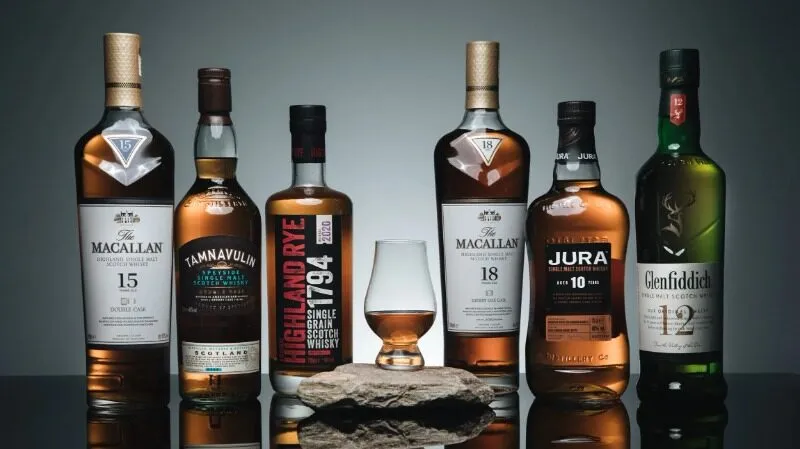Whisky can seem a bit intimidating when you’re just starting out. There are so many different types, brands, and flavors that it’s hard to know where to begin. But don’t worry – whisky doesn’t have to be complicated. Once you understand the basics, you’ll feel much more confident choosing a bottle or ordering a glass. Whether you’re sipping it neat, on the rocks, or in a cocktail, this guide will help you get started with whisky.
What is whisky?
At its core, whisky is a distilled alcoholic beverage made from fermented grains. The grains can vary – barley, corn, rye, and wheat are the most common – but the end result is a flavorful drink aged in barrels to develop its unique taste.
Whisky comes in many forms, but they all follow a similar process: the grains are mashed, fermented, distilled, and then aged in barrels for several years. Over time, the whisky absorbs flavors from the wood, which gives it that rich, complex taste.
You might have noticed that sometimes it’s spelled “whisky” and other times “whiskey.” What’s the difference? It mostly comes down to geography. In Scotland and Canada, it’s “whisky.” In the U.S. and Ireland, it’s “whiskey.” No matter the spelling, they’re both made in similar ways.
Different types of whisky
Whisky isn’t just one thing – there are different types, each with its own distinct flavor. Here’s a quick breakdown of the main kinds you’ll come across:
- Scotch whisky: Made in Scotland, Scotch is usually aged for at least three years. It’s known for its rich, smoky flavor, especially if it comes from the Islay region, where peat is used during the drying process. Other regions like Speyside and Highland produce whiskies that are more fruity or floral.
- Bourbon: This is American whisky, and it must be made from at least 51% corn. Bourbon tends to be sweeter than Scotch and often has notes of vanilla, caramel, and oak. It’s typically aged in new charred oak barrels, which gives it a deep, rich flavor.
- Irish whiskey: Made in Ireland, this whiskey is usually triple-distilled, which makes it smoother and lighter than Scotch or Bourbon. It’s a great choice for beginners because it’s easy to drink and has a mild, approachable flavor.
- Rye whisky: Rye whisky is made with a higher percentage of rye grain, which gives it a spicier, drier taste compared to Bourbon. It’s especially popular in cocktails like the Manhattan or Old Fashioned. If you like a bit of bite in your drink, give rye a try.
How to choose whisky based on taste preference
Whisky comes in so many flavors that there’s bound to be one that matches your taste. Here’s how to figure out what might work for you:
- If you like sweet drinks: Bourbon is a great starting point. Because it’s made with corn, it tends to have sweeter notes like caramel, vanilla, and even a bit of cinnamon. Speyside Scotch is another good option, as it often has fruity and honeyed flavors.
- If you like smoky flavors: Scotch from the Islay region is your go-to. These whiskies are known for their bold, smoky taste that comes from using peat in the drying process. If you’re new to whisky, you might find this a bit intense at first, but if you love smoke, you’ll appreciate its complexity.
- If you like light and smooth: Try Irish whiskey. Its triple distillation process makes it very smooth and easy to drink, with light, fruity flavors. This is perfect for someone who’s just getting started with whisky.
- If you like spicy and bold: Rye whisky is a great choice. The higher rye content gives it a spicier kick, with flavors like pepper, cloves, and cinnamon. It’s great for sipping or mixing in cocktails if you want something with a bit more punch.
Whisky terms to know
When you’re new to whisky, some of the terms can be confusing. Here are a few key terms that’ll help you sound like a pro:
- Single malt: Whisky made from malted barley at a single distillery. It’s usually more complex and full of character than blended whiskies.
- Blended whisky: A mix of different whiskies from various distilleries. Blended whisky tends to be smoother and more approachable, making it a good option for beginners.
- Cask strength: Whisky that’s bottled straight from the barrel without being diluted with water. This means it’s stronger, but you can add water to taste.
- Age statement: This tells you how long the whisky has been aged in barrels. The general rule is, the older the whisky, the more complex the flavor – but that doesn’t always mean it’s better. Try a range of ages to find what you like.
How to taste whisky
Now that you know a bit more about whisky, let’s talk about how to taste it properly. Tasting whisky is an experience, so take your time and enjoy it.
- Choose the right glass: Use a tulip-shaped glass if you can. This shape concentrates the aromas and enhances the tasting experience.
- Smell it first: Swirl the whisky gently in the glass and take a moment to smell it. What aromas do you pick up? It might be fruity, smoky, or spicy.
- Take a small sip: Let the whisky sit on your tongue for a few seconds before swallowing. This helps you pick up the different flavors. Is it sweet? Smoky? Spicy? Try to identify the different layers.
- Add water if you like: Don’t be afraid to add a few drops of water. This can open up the flavors and make the whisky more approachable. Experiment with different amounts to see what works for you.
Buying whisky for beginners
When you’re just starting out, it can be tempting to splurge on an expensive bottle. But you don’t need to break the bank to enjoy whisky. Here are some tips for buying your first bottles:
- Start with a variety pack: Many stores sell sampler packs with small bottles of different whiskies. This is a great way to try a few different types without committing to a full bottle.
- Don’t worry about age: Older doesn’t always mean better. Many young whiskies are fantastic, especially if they’re well-made. Start with something in the 10- to 12-year range if you’re looking for an age statement.
- Ask for recommendations: If you’re at a whisky shop or liquor store, don’t hesitate to ask for help. The staff can point you toward good beginner-friendly options based on your taste preferences.
Conclusion
Choosing whisky doesn’t have to be overwhelming. Start by understanding the different types, experiment with what suits your taste, and don’t be afraid to ask for advice. Whisky is all about exploration, so have fun with it!


